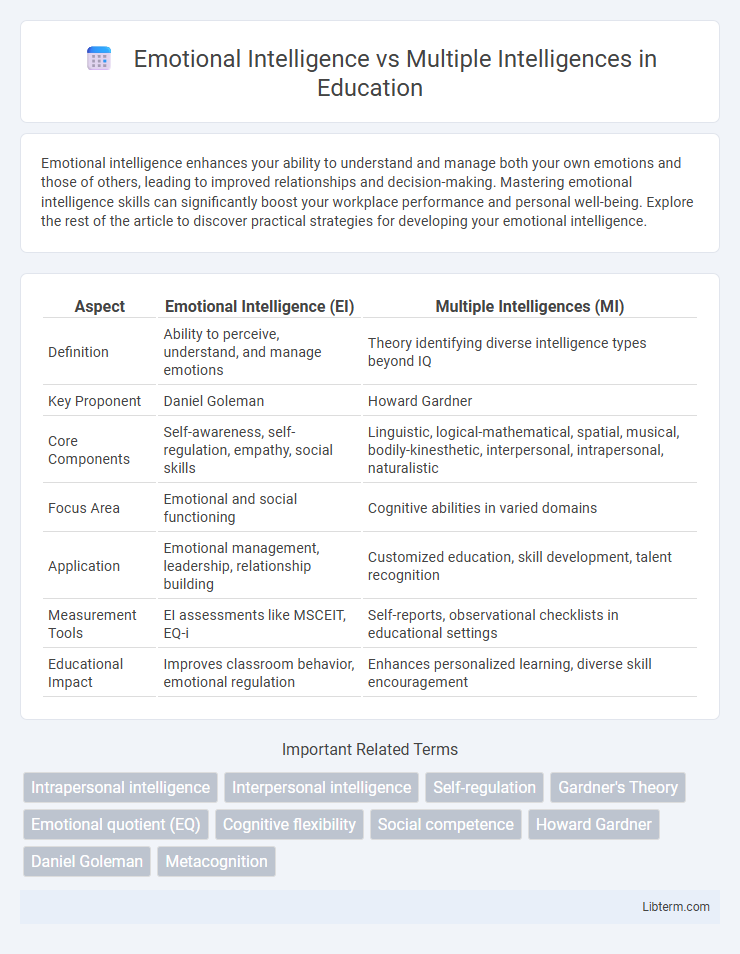Emotional intelligence enhances your ability to understand and manage both your own emotions and those of others, leading to improved relationships and decision-making. Mastering emotional intelligence skills can significantly boost your workplace performance and personal well-being. Explore the rest of the article to discover practical strategies for developing your emotional intelligence.
Table of Comparison
| Aspect | Emotional Intelligence (EI) | Multiple Intelligences (MI) |
|---|---|---|
| Definition | Ability to perceive, understand, and manage emotions | Theory identifying diverse intelligence types beyond IQ |
| Key Proponent | Daniel Goleman | Howard Gardner |
| Core Components | Self-awareness, self-regulation, empathy, social skills | Linguistic, logical-mathematical, spatial, musical, bodily-kinesthetic, interpersonal, intrapersonal, naturalistic |
| Focus Area | Emotional and social functioning | Cognitive abilities in varied domains |
| Application | Emotional management, leadership, relationship building | Customized education, skill development, talent recognition |
| Measurement Tools | EI assessments like MSCEIT, EQ-i | Self-reports, observational checklists in educational settings |
| Educational Impact | Improves classroom behavior, emotional regulation | Enhances personalized learning, diverse skill encouragement |
Introduction to Emotional Intelligence and Multiple Intelligences
Emotional Intelligence (EI) involves the ability to recognize, understand, and manage one's own emotions as well as those of others, playing a crucial role in personal and professional success. Multiple Intelligences theory, developed by Howard Gardner, identifies diverse cognitive strengths beyond traditional IQ, including linguistic, logical-mathematical, spatial, musical, bodily-kinesthetic, interpersonal, intrapersonal, and naturalistic intelligences. While EI emphasizes emotional awareness and regulation, Multiple Intelligences broaden the understanding of human capabilities by categorizing varied intellectual skills and talents.
Defining Emotional Intelligence: Core Components
Emotional Intelligence encompasses core components such as self-awareness, self-regulation, motivation, empathy, and social skills, which enable individuals to recognize and manage both their own emotions and those of others. Unlike Multiple Intelligences theory, which identifies varied cognitive abilities like linguistic, logical-mathematical, and spatial intelligences, Emotional Intelligence specifically targets emotional and interpersonal competence. Research by Daniel Goleman highlights that high Emotional Intelligence correlates with improved leadership, communication, and conflict resolution abilities.
Understanding Multiple Intelligences Theory
Understanding Multiple Intelligences Theory involves recognizing that intelligence extends beyond traditional IQ measures to include diverse cognitive abilities such as linguistic, logical-mathematical, spatial, musical, bodily-kinesthetic, interpersonal, intrapersonal, and naturalistic intelligences. Emotional Intelligence, while related, specifically focuses on the capacity to perceive, assess, and manage emotions in oneself and others, which overlaps mainly with interpersonal and intrapersonal intelligences in Gardner's framework. Emphasizing Multiple Intelligences Theory allows educators and psychologists to tailor learning and development approaches according to individual strengths across various cognitive domains.
Key Differences Between Emotional and Multiple Intelligences
Emotional intelligence primarily involves the ability to recognize, understand, and manage one's own emotions and the emotions of others, facilitating effective interpersonal communication and emotional regulation. Multiple intelligences theory, developed by Howard Gardner, encompasses a broader range of cognitive abilities, including linguistic, logical-mathematical, musical, bodily-kinesthetic, spatial, interpersonal, intrapersonal, naturalistic, and existential intelligences. The key difference lies in emotional intelligence's focus on emotional and social skills, while multiple intelligences address diverse intellectual capacities across various domains.
Historical Background and Evolution of Both Concepts
Emotional Intelligence (EI) emerged prominently in the 1990s after psychologists Peter Salovey and John Mayer introduced the term, with Daniel Goleman's 1995 book popularizing it as the ability to perceive, understand, and manage emotions effectively. Multiple Intelligences theory, proposed by Howard Gardner in 1983, challenged traditional IQ measurement by identifying diverse cognitive abilities, including linguistic, logical-mathematical, spatial, and interpersonal intelligences. Both concepts evolved to expand the understanding of human capabilities beyond academic intelligence, influencing educational practices and psychological research globally.
Practical Applications in Education and the Workplace
Emotional Intelligence (EI) enhances self-awareness, empathy, and interpersonal skills critical for teamwork and leadership development in both educational and workplace settings. Multiple Intelligences theory supports differentiated instruction by recognizing diverse learning styles such as linguistic, logical-mathematical, and kinesthetic intelligences, allowing educators and managers to tailor strategies for maximum engagement and productivity. Integrating EI with Multiple Intelligences leads to holistic development, improving communication, problem-solving, and collaboration across diverse groups.
Impact on Personal and Professional Success
Emotional intelligence, encompassing self-awareness, empathy, and emotional regulation, profoundly influences interpersonal relationships and leadership effectiveness in both personal and professional contexts. Multiple intelligences theory highlights diverse cognitive abilities such as linguistic, logical-mathematical, and interpersonal skills, enabling individuals to excel in various domains by leveraging their specific strengths. Integrating emotional intelligence with multiple intelligences fosters holistic personal growth and enhances career adaptability, collaboration, and problem-solving capabilities.
Criticisms and Limitations of Each Model
Emotional Intelligence (EI) faces criticism for its ambiguous measurement standards and the overlap with personality traits, raising questions about its distinct scientific validity. Multiple Intelligences (MI) theory is often challenged due to the lack of empirical evidence supporting the independence of the proposed intelligences and its potential to dilute the traditional concept of intelligence. Both models encounter limitations in practical application, with EI struggling to separate emotional skills from general intelligence and MI encountering difficulties in assessment and educational implementation.
Measuring Emotional Intelligence and Multiple Intelligences
Measuring Emotional Intelligence (EI) typically involves tools like the Mayer-Salovey-Caruso Emotional Intelligence Test (MSCEIT), which assesses abilities in perceiving, facilitating, understanding, and managing emotions. Multiple Intelligences (MI), proposed by Howard Gardner, are evaluated through diverse assessments that gauge linguistic, logical-mathematical, spatial, musical, bodily-kinesthetic, interpersonal, intrapersonal, and naturalistic intelligences, often using observational and performance-based methods. While EI measurements focus specifically on emotional and social skills, MI assessments provide a broader profile of cognitive strengths across varied domains.
Integrating Emotional and Multiple Intelligences for Holistic Development
Integrating Emotional Intelligence with Multiple Intelligences fosters holistic development by enhancing self-awareness, interpersonal skills, and diverse cognitive abilities such as linguistic, logical-mathematical, and spatial intelligences. This combined approach supports adaptive learning strategies and emotional regulation, facilitating better problem-solving and creativity across various domains. Cultivating both emotional and multiple intelligences empowers individuals to navigate complex social environments and optimize personal and academic growth.
Emotional Intelligence Infographic

 libterm.com
libterm.com